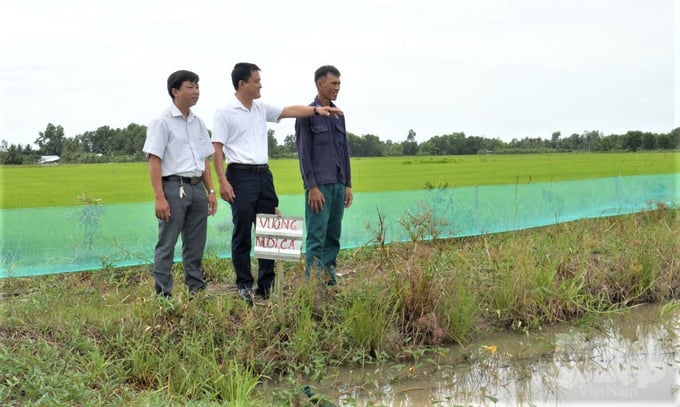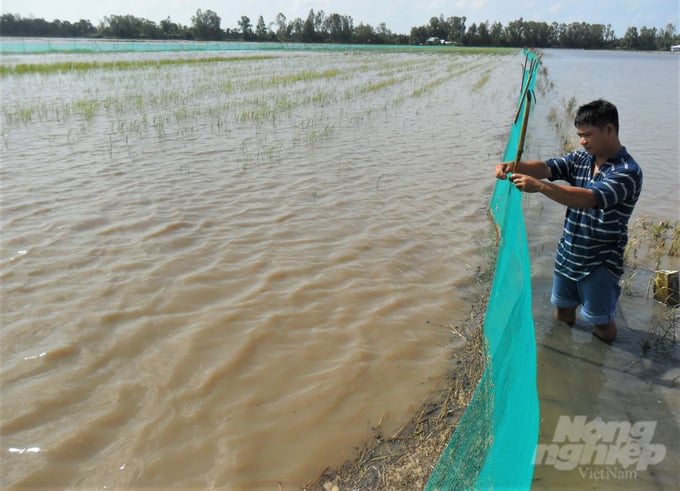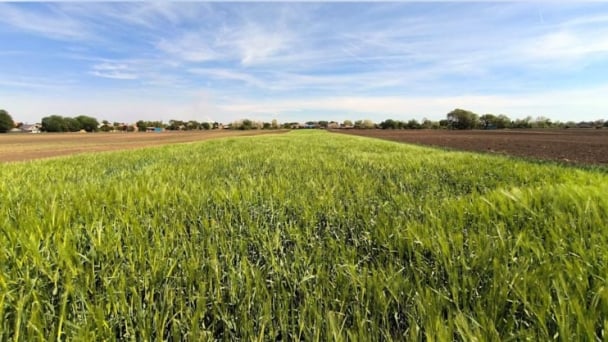June 19, 2025 | 21:03 GMT +7
June 19, 2025 | 21:03 GMT +7
Hotline: 0913.378.918
June 19, 2025 | 21:03 GMT +7
Hotline: 0913.378.918

Hau Giang encourages farmers to convert ineffective rice-cultivating land to fish farming and supports the construction of the model "Fish farming in rice fields towards enhancing value associated with community linkage". Photo: Trung Chanh.
Taking advantage of water sources from rainwater and the flood season, for many years, instead of investing in growing third-crop rice in ineffective places farmers in Hau Giang province have switched to aquaculture.
The fish farming model in rice fields is superior in terms of investment because it does not cost money to buy food, the fish lives in a natural environment so the meat is delicious and easy to consume. Cutting down on the rice crop also reduces the risk of disease and organic residue left after the fish farming crop, which proves to be economically efficient considering the fertilizer costs.
Having a full understanding of these benefits, Hau Giang plans to convert 2,000 ha of ineffective rice growing land (third crop) to implementing a fish farming model in rice fields, increasing the total target for developing aquaculture areas in rice fields to 7,500 ha in 2023.
Deputy Director of Hau Giang Department of Livestock Production, Animal Health and Fisheries Nguyen Thi Thuy Lam said that in order to encourage people to expand aquaculture areas, the province has the plan to support the construction of the model “fish farming in rice fields towards enhancing value associated with community linkage" with a total area of 200 ha, the local authorities recommend snakehead as the species for the model.
Subjects supported in implementing the model include households that have good knowledge and techniques, agricultural works that meet technical requirements, workers of working age to manage the model, and sufficient funds to invest during implementation.
Priorities are given to households that are members of cooperative groups and cooperatives in the product consumption linkage, especially direct links between those who implement the model and processing and consumption facilities. The model’s focus is to create products that ensure food safety and hygiene.
Making the most of ineffective rice growing areas in the province by raising a number of aquatic species with high economic value seems to be a solution in line with market demand. It contributes to increasing income and improving the quality of life for farmers.
Regarding the main subject for the model, Hau Giang chose marbled snakehead to increase the aquaculture area in rice fields. Farmers can also invest in raising some plant-eating, organic fish species such as carp or bighead carp to take advantage of natural food sources available in the fields.

The model of fish farming in rice fields has the advantage of low investment costs thanks to the available food source. The fish lives in a natural environment so the meat quality is high. Photo: Trung Chanh.
On the other hand, the province builds a highly effective example model and makes it a place for coal farmers to visit, study, and replicate. Hau Giang Department of Livestock Production, Animal Health and Fisheries currently have two forms of “fish farming in rice fields” model that are applied effectively by farmers.
The first is improved extensive farming where farmers take advantage of flooded fields to set nets along the banks and stock fish fingerlings, mainly white fish that eat plants, algae, and organic matter. The second form is semi-intensive farming. Farmers invest in digging surrounding ditches, netting and stocking snakehead, catfish, perch and some white fish species.
According to the plan of Hau Giang province, the funding source to support the implementation of aquaculture model development in 2023 is more than VND 29.8 billion, of which the state budget supports nearly VND 2.5 billion, and the rest is the people's counterpart capital.
Regarding aquaculture in the first months of 2023, Hau Giang farmers have raised 5,382 ha of aquatic products, including some key species such as pangasius, tilapia, and eel. The total harvested aquatic product output is estimated at more than 29,400 tons, mainly aquatic products which account for more than 28,000 tons. Pangasius contributes the most in the output proportion with 14,100 tons, next is tilapia with 538 tons, and and eel with 493 tons. Domestic aquatic output reaches 1,350 tons, including shrimp, river fish and wild fish.
Translated by Samuel Pham
![Turning wind and rain into action: [9] Digitizing hydrometeorological data in response to climate change](https://t.ex-cdn.com/nongnghiepmoitruong.vn/608w/files/news/2025/06/17/z6704423696987_15fd32ffc26d590d204d520c9dac6786-nongnghiep-165943.jpg)
(VAN) Farmers have begun accessing hydrometeorological applications to adjust their cropping schedules, aiming to ensure productivity and adapt to climate change.
![Turning wind and rain into action: [8] Real-time salinity detection and early warning technology](https://t.ex-cdn.com/nongnghiepmoitruong.vn/608w/files/news/2025/06/17/z6704423696987_15fd32ffc26d590d204d520c9dac6786-nongnghiep-151127.jpg)
(VAN) Thanks to the integration of modern hydrological-hydraulic models, remote sensing technologies, and artificial intelligence, the accuracy of hydrological forecasting has significantly improved.
![Turning wind and rain into action: [7] Early disaster warnings help marine farmers minimize losses](https://t.ex-cdn.com/nongnghiepmoitruong.vn/608w/files/news/2025/06/17/z6704423696987_15fd32ffc26d590d204d520c9dac6786-nongnghiep-142942.jpg)
(VAN) In recent years, thanks to early disaster warnings and forecasting, marine farmers in Khanh Hoa province have been able to reduce risks and losses, thereby improving production efficiency.
![Turning wind and rain into action: [6] ‘Four on-the-spot’ disaster management software](https://t.ex-cdn.com/nongnghiepmoitruong.vn/608w/files/news/2025/06/17/e5a48259d6a262fc3bb3-nongnghiep-183800.jpg)
(VAN) By simply activating the scenario on the disaster management software, the relevant authorities immediately know how many households need to be evacuated, where to evacuate them to, and by what means of transportation…
![Turning wind and rain into action: [5] Hue applies modern technology in disaster forecasting](https://t.ex-cdn.com/nongnghiepmoitruong.vn/608w/files/news/2025/06/17/z6704423696987_15fd32ffc26d590d204d520c9dac6786-nongnghiep-093938.jpg)
(VAN) In Hue city, modern technology has recently been applied in meteorological and hydrological forecasting and warning, helping to reduce the damage caused by natural disasters.

(VAN) A cutting-edge farming technique being implemented on an experimental ranch in Arizona's Sonoran Desert has already saved a billion gallons of water over five years, according to Civil Eats.

(VAN) Poultry and pig production and the environment can be boosted through enhanced water technology, according to new research.